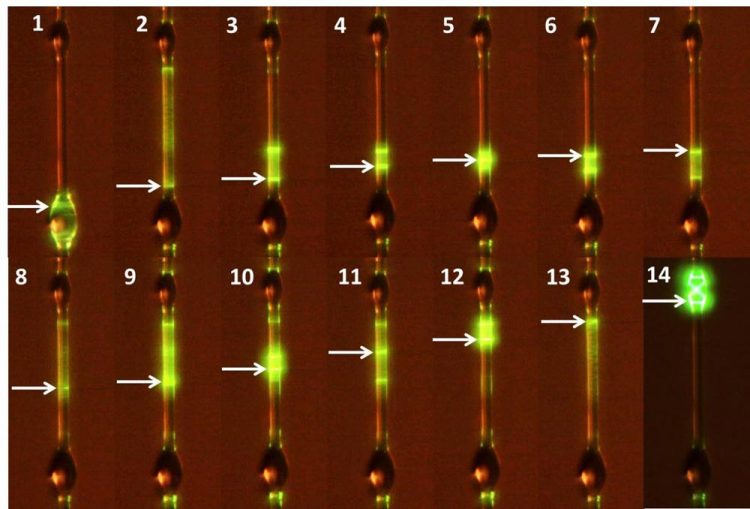New fabrication and thermo-optical tuning of whispering gallery microlasers

A thin coating (around one micron thick) is formed on the capillary. Laser light can be created at almost any point on the capillary, indicated by the white arrow. The thin coating allows for the fabrication of much smaller microlasers. Credit: OIST
Microlasers are tiny optical devices a few tens of micrometres in diameter that are able to create intense light with only one colour or wavelength. OIST researchers found a new method to fabricate a special type of glass microlaser, called whispering gallery microlasers.
Whispering gallery microlasers are doughnut-shaped or spherical devices produced from glass doped with rare earth elements, such as erbium or ytterbium (Er or Yb). Inside the microlasers, light is reflected over and over creating a 10-100 metre long optical path within a tiny device that's the size of a grain of sand.
Taking advantage of the different melting temperatures of silica and Er or Yb doped phosphate glass, OIST scientists have devised a new way to produce microlasers via glass wetting, or glass-on-glass fabrication. In this new technique, a strand of Er or Yb doped phosphate glass is melted and allowed to flow around a hollow capillary of silica.
This is possible because of the different melting temperatures of silica and phosphate glass at 1500°C and 500°C, respectively. This technique produces bottle-shaped microlasers, which are 170 micrometres in diameter. The bottle-shape can then be modified to become a thin coating of only a few micrometres in diameter around the capillary.
While fabricating doped glass microlasers using traditional methods can be tedious, with each individual sphere being attached to a glass strand, this glass wetting technique allows scientists to make any number of microlasers quickly and in series.
This technique also facilitates a new way of tuning the wavelength or colour of light emitted by the microlasers. The tuning is achieved by a combination of pressure and temperature. Compressed gas passed through the capillary cools the walls of the hollow structure. This cooling effect makes the diameter of the microlaser contract, which changes the laser output wavelength.
Microlasers prepared with this new technique were used to measure the air flow in microfluidic devices and have been shown to be more sensitive than commercial electronic flow sensors, as well as 10,000 times smaller.
“We wanted the ability to tune micro-scale lasers without increasing the size and the complexity of the device and keeping high quality,” points out Dr Jonathan Ward, the first author of this study. “This could be a step towards the quick and easy fabrication of smaller devices for biosensing and optical communications.”
Media Contact
All latest news from the category: Physics and Astronomy
This area deals with the fundamental laws and building blocks of nature and how they interact, the properties and the behavior of matter, and research into space and time and their structures.
innovations-report provides in-depth reports and articles on subjects such as astrophysics, laser technologies, nuclear, quantum, particle and solid-state physics, nanotechnologies, planetary research and findings (Mars, Venus) and developments related to the Hubble Telescope.
Newest articles

Bringing bio-inspired robots to life
Nebraska researcher Eric Markvicka gets NSF CAREER Award to pursue manufacture of novel materials for soft robotics and stretchable electronics. Engineers are increasingly eager to develop robots that mimic the…

Bella moths use poison to attract mates
Scientists are closer to finding out how. Pyrrolizidine alkaloids are as bitter and toxic as they are hard to pronounce. They’re produced by several different types of plants and are…

AI tool creates ‘synthetic’ images of cells
…for enhanced microscopy analysis. Observing individual cells through microscopes can reveal a range of important cell biological phenomena that frequently play a role in human diseases, but the process of…





















